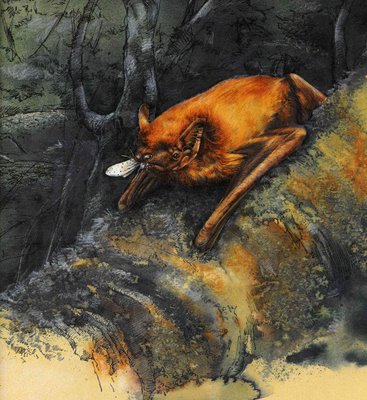
For those of you out there that are old hat with watercolor, the technique I'm going to talk about is bound to be old news. Others might have seen the results, but never quite knew how it was obtained.
When I was younger, I found a great book called 'The Undercliff' by Elaine Franks. The book is a naturalist's sketchbook which explores a place in England along the south shores of Devon to Dorset. In this book, Elaine Franks shares her impressions, from tiny sketches of insects and flowers to full page illustrations of a particular resident to these woods. When I first saw these images I was very new to painting in watercolor. Most of my work in those days was simple, unchallenging washes and dry brush work. The impression these paintings had on me was distinct. I looked at the depth of color and vibrancy, the intriguing textures and was stupified. I really had no idea how to even attempt painting in this manner. I was saved by my teacher at the time, Mrs. Salinger. I brought 'The Undercliff' into art class and asked her to leaf through it with me. I showed her the paintings I had marked to see if she could shed any light on the technique. The pieces are mixed media, often watercolor over ink drawing, but the pure watercolor technique itself was pretty readily decipherable to my teachers more trained eye.
The first piece we worked out involved wet on wet work. This technique was in my repertoire then, but not quite to the extent that it was used in this work. In the bat painting, much of the loose, flowing, smooth gradation in colors, especially well seen in the soft grading of colors along the log is wet on wet. In the Moth painting, wet on wet is also used. In this piece, the pigments are laid on less uniformly and the vein like pattern of water and pigment traveling along, through capillary action is left in the final image. Dependent on what type of paper you are using, and the degree to which you are interested in controlling this capillary action in your painting, you can either use this as an effect or smooth it while the surface is still wet, dependent on whether or not the veining is desirable to you.
Moving on, the wet on wet area on the log in the Bat painting is punctuated by some interesting crackle patterns... there are similar patterns in distinct patches in the Moth piece. This pattern, a very attractive organic looking effect is obtained by laying in a wash and selectively sprinkling a cluster of salt grains on the wet paper. The grains are left until the paper is completely dry, leaving behind these beautiful patterns. Using different kinds of salts can give you different effects. The best, most dramatic effect comes from the large flakes of kosher salt (This remains of my favorite techniques - used very selectively though).
Lastly, a similar effect can be seen in the Moth, most noticeably in the area directly above the large moth in the foreground. This is a blotting effect, most likely using a crumpled-up paper towel. Calculated removal of pigment and water from your paper can create these beautiful patterns, breaking up your pools of pigment, exposing colors from the washes below.
In the end, what appeared to me as a mystery when I first saw these images in the pages of 'The Undercliff', turned out to be relatively simple in practice. It was a great eye-opening experience for me to see the flexibilities within the watercolor medium, even when painting boldly like Elaine Franks' work.

2 comments:
Hi BMClock,
lovely to hear of your interest, and great to hear technique being discussed in an informed and intelligent way - it's only ever a means to an end though, the observation of, and enthusiasm for the subject always remaining paramount.
Even after forty years with the same watercolour box (it also belonged to my mother when she was at school, so it's even older than me!) I still get a thrill from the act of painting - seeing a wet wash spread out or pigments split into a spectrum of colours as they granulate. Great to know you've discovered the same enjoyment, would love to see some of your own work.
Elaine Franks
garden.studio@btinternet.com
The internet is a wonderful thing. I was unable to find The Undercliff in the US and purchased one from the UK. I use this book extensively and I am thrilled to hear from Elaine Franks. I continue to learn from her paintings.
Post a Comment